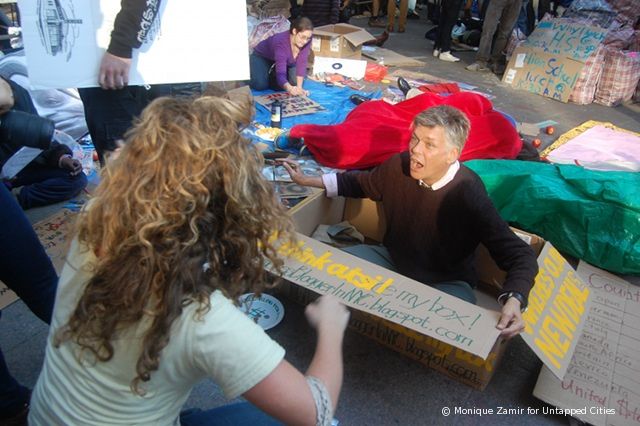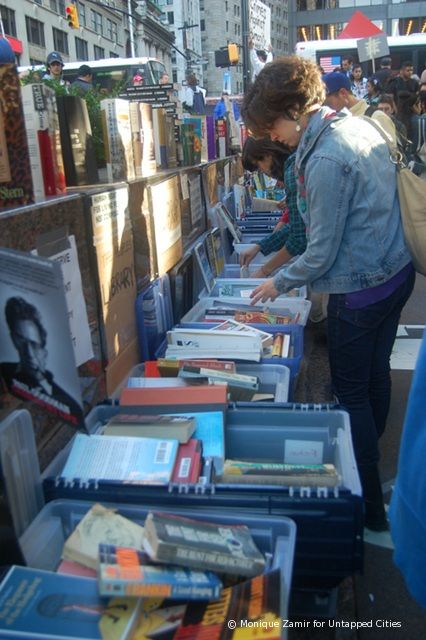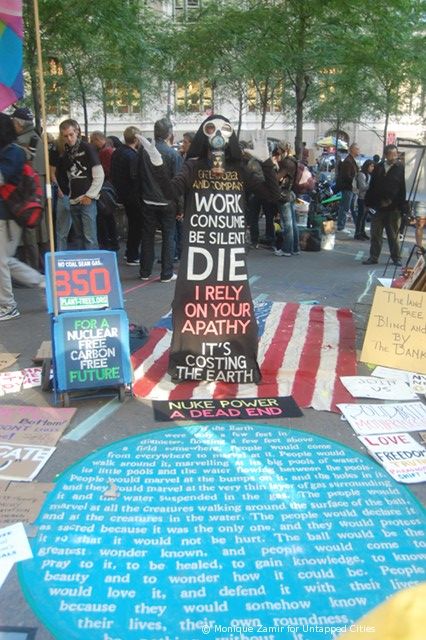NYC’s Forgotten ‘War on Christmas Trees’
Discover how an obscure holiday crackdown affects festive street vendors today!


The national “Occupy” movements may have taken their cues from the takeover of public spaces in Spain and the Arab Spring, but Occupy Wall Street has actually pitched its camp on a privately owned public space, or “POPs” in urban planning terminology. New York City has over 500 of these types of spaces and you probably recognize them in the mini plazas and arcades of midtown Manhattan. The program was developed in 1961, allowing for private development of public use spaces by developers in exchange for Floor Area Ratio bonuses (FAR).

While the legal status of POPs were relatively unknown to the general public before Occupy Wall Street, Untapped has an interesting connection to the topic- one of our journalists is writing her thesis on POPs in New York City. She referred us to a 2008 piece for Urban Studies in which Jeremy Németh studied 163 New York POPs and came to the conclusion that “as developer priorities are often fiscally driven, most approaches severely limit political, social and democratic functions of public space and produce a constricted definition of the public. As such, privately owned public spaces have deleterious effects on concepts of citizenship and representation, even as they become the new models for urban space provision and management.”
Zuccotti Park is owned by Brookfield Office Properties. In an ironic retelling of the history, this space was called Liberty Park until 2006 . It was then renamed for John Zuccotti, former City Planning Commission chairman and current chairman of Brookfield Properties, after it underwent an $8 million renovation project. The massive red sculpture, the park’s standard, Mark di Suvero’s “Joie de Vivre” (Joy of Life) was placed for the park’s dedication in 2006. There is a relevant story behind this; Di Suvero was present for the park’s dedication, but the then 72-year-old wasn’t allowed to speak. The sculptor told one Downtown Express writer ““Nah, they’re scared. I got arrested during the [Republican] convention for saying Bush lied. I was one of the oldest people that got hauled in.” Di Suvero likely appreciates that his sculpture is a frequent meeting point for Occupy Wall Street’s many working groups.

As per regulations, the public is ostensibly allowed to use the park 24 hours a day, 7 days a week and because of the park’s POPs status, protesters can’t be removed by the managing organization or the police. The park can be regulated to a certain extent however, and Brookfield Management recently did just that according to DNAInfo, including “banning activity such as lying down on benches, sitting areas and walkways and prohibiting tarps and sleeping bags.” Although enforcement is a different story, this could be the beginning of a larger push. Interestingly, if Zuccotti were a public park, the police could enforce curfew hours, and end the sleepovers
immediately, as Boston’s police did in a mass arrest at Occupy Boston.
Nemeth believes that the POPs model is especially “problematic when viewed through a lens of citizenship and representation. The right of private parties to exclude certain individuals and groups from publicly accessible spaces is a question of citizenship, or ‘the right to be considered in the range of forums, alliances and nodes which constitute governance.’ The denial of access to, or inclusion in, publicly accessible space then becomes a denial of citizenship and representation in our collective public forums. Citizenship and representation are directly related to visibility and to making physical appearances in publicly accessible space, so space cannot be called truly public if its ‘maintenance requires the marginalization or exclusion’ of a particular constituency.

We decided to take a look at how people are using these spaces. It is clear they are in for the long haul, including composting and greywater filtration. Descend upon the park’s eastern side, and you’ll be greeted by a surprisingly extensive library. There are three info booths throughout the park, the people staffing them will inform you about working groups that need help, meetings you can attend, workshops/forums going on, marches that are happening, basically, they’re the liaison for newcomers and working groups. Delve further inwards and you’ll find a kitchen, complete with a system for reusing their greywater (greywater is all waste water excluding sewage water). Someone came by just last week and offered to build a grey water system where they pour their used dishwater into a vat of wood chips and gravel, which absorbs dishwater contaminants, then the water passes through plant roots, which utilize the phosphorous and nitrogen in the dishwater as nutrients. The overflow goes into a bucket, which is then used to water the plants in Zuccotti park.


You may find a barber giving hair cuts, a comfort station offering clothing, toiletries, gloves, blankets and sleeping bags, a free cigarette-rolling station that accepts tobacco donations. The day I was there, people were making and giving out seed bombs, a guerrilla gardening tactic comprising small balls of seed and dirt that you can just throw in an empty lot, anywhere with dirt, and let grow. Depending on what time of day you’re there, you could find a drum circle, dancers/performers, and musicians of many varieties. Talib Kweli and Neutral Milk Hotel’s Jeff Mangum have both made surprise appearances.

“It’s a community thing” commented Erin Goldberger, of Brooklyn. “There’s nothing better than going somewhere and meeting new people. Everyone talking here is refreshing.” Another North Carolina woman remarked that the park is “functioning as an amazing place to dialogue. It’s an ideal scene for the exchange of different ideas. It’s amazing to have a place to talk about this.”
In a protest of this nature where there is a constant flow of people both on the ground and online, the boundaries exceed the physical space. The park has evolved into a place where strangers, friends, and family members can congregate, converse, teach, engage and learn. It is a place for passionate discussions, a forum for music, an open gallery for art, a modern day social movement. It may be frustrating that there is no concrete list of demands, only idealistic ambiguities on what should be done. It may frustrate some that there is still disorganization on the ground, that transparency is still being achieved, that it can be cumbersome to try and get in contact with the right people. But allegedly the protest’s intentions are far greater than focusing on just one task like abolishing corporate personhood or holding banks and Wall Street firms responsible for their actions preceding the recession. Instead, this movement seeks to encourage public involvement, to harness the talents, skills and ideas of a mass of individuals in a collaborative way.
As a fledgling movement, and one that is comprised of so many people working on their own time, it is almost a prerequisite that things are disorganized, that objectives are still somewhat unclear. Many in the movement believe that the best way to do achieve clarity is through utilizing a publicly accessible headquarters where people are encouraged to come and contribute as little or as much as they are comfortable with. But the fact that this is a privately owned public space is bound to yield problems in the future. But for now, this POPs has served Occupy Wall Street as well as any truly public space in New York City could have.
Get in touch with the author @zamirmon. Additional reporting by Janos Marton, Michelle Young and Priyanka Jain.
Subscribe to our newsletter